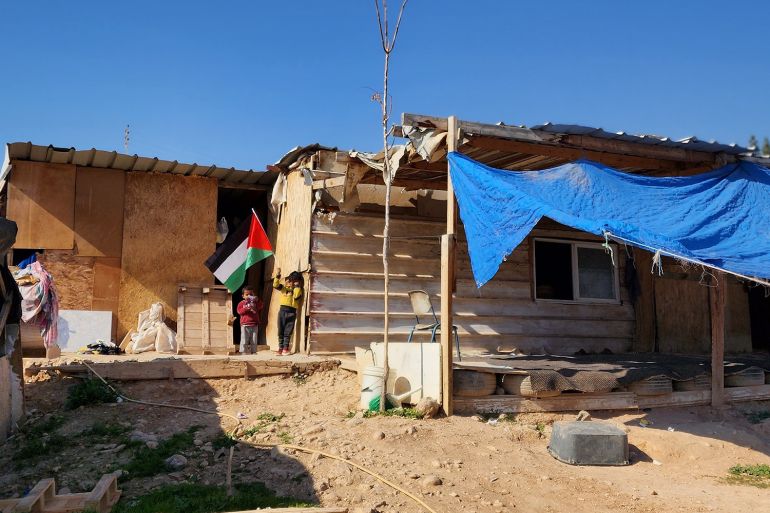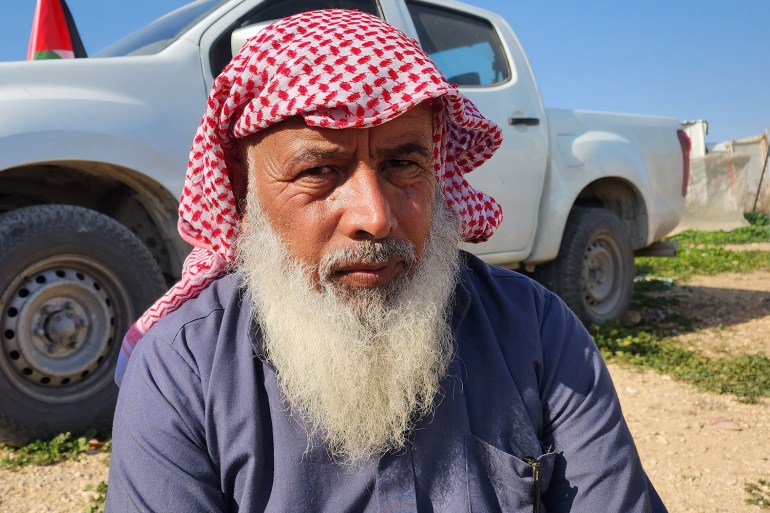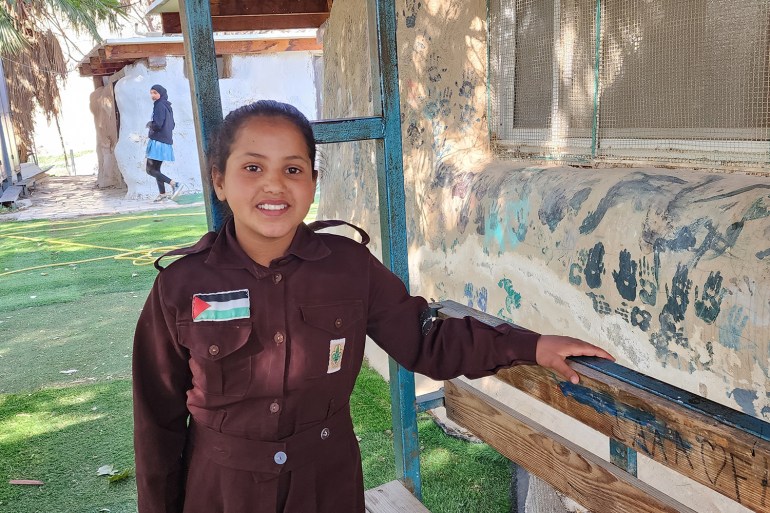Palestinians in Khan al-Ahmar stand ground amid displacement plan
The occupied West Bank village’s years-long legal battle with Israeli authorities for its survival has captured international attention.

Khan al-Ahmar, occupied West Bank – Yusra Abu Eid stands to lose not just her house, but the entire village of Khan al-Ahmar that she has, for years, called home.
The Palestinian village on the eastern outskirts of Jerusalem faces a potential imminent demolition by Israeli authorities that would forcibly displace the 34-year-old, along with its 220 other residents living in tents and tin homes.
Keep reading
list of 3 itemsPalestine: Unite or die
Israel orders police to remove Palestine flags from public spaces
“We have nowhere to go,” Abu Eid, who moved to Khan al-Ahmar from the nearby town of al-Eizariya to live with her husband, told Al Jazeera.
Khan al-Ahmar has for years captured international attention due to its residents’ legal battle with Israeli authorities over the village’s survival.
In September 2018, the Israeli Supreme Court greenlit the village’s removal, leaving it open to being demolished at any time. Such plans, however, have since been put on hold several times.
On January 21, Itamar Ben Gvir, the far-right minister of national security in Israel’s new government, ordered the village to be immediately cleared. His plans for a visit to the site along with another controversial politician, Bezalel Smotrich, met protests at the village.
The Israeli government has until February 1 to explain to the Supreme Court why the village, which lies in what is known as Area C under Israeli military control, has not been demolished yet, or to put forward a plan for its demolition.
‘Watched all the time’
Located a few kilometres from Jerusalem, Khan al-Ahmar is sandwiched between two major illegal Israeli settlements, Maale Adumim and Kfar Adumim.
It lies along a key corridor where Israel has aimed to expand and link major settlements in occupied East Jerusalem with the Jordan Valley, under what it calls the E1 settlement project, which would effectively cut the occupied West Bank into two.
The Israeli government plans to relocate the residents to an area next to a landfill about 12km (7.4 miles) away, near the Palestinian village of Abu Dis in East Jerusalem.
The forcible transfer of protected people in occupied territory is classified as a war crime under international law.
Resident Mohammad Abu Eid Jahalin said that under the Israeli occupation, the village and its surrounding settlements have been economically besieged for years. This has led to limited grazing areas for livestock, despite that being the inhabitants’ primary source of livelihood. He also said Israeli authorities have revoked all the Israeli work permits for the men in the village.

Jahalin was born in Khan al-Ahmar after Israel displaced his clan from the Naqab (Negev) region in the south in 1951. Following the occupation of the West Bank in 1967, the village came under Israeli military control.
“We are being watched all the time by drones that film everything we do, and we are not allowed to bring in any building materials or equipment. If one of us sets up a new tent it will be demolished the next day,” Jahalin, 53, told Al Jazeera.
The only school in the community, built out of mud and old car tyres, has also been facing destruction.
Sitting in the schoolyard, no more than four metres (13 feet) on all sides, six-year-old Alaa Talib Youssef sat with her peers eating food during a break from class.
“We will not leave,” she said about the potential clearance.
Describing her school as “more beautiful” than her house, Youssef said she hoped to become a “hairdresser” when she was older so she could tend to the women in the village who must now travel long distances to access a salon.
Her eight-year-old brother, meanwhile, had his eyes on something seemingly much simpler: a “big yard” to play football with his classmates and schoolmates.
“There is no level ground in the village where we can play – even the schoolyard is very narrow,” he said.
Battle for ‘Area C’
The Khan al-Ahmar school serves about 200 children from the village and nearby Bedouin communities, up to the ninth grade. Pupils then have to travel to al-Eizariya, which hinders the opportunities for many, particularly female students, to complete their education due to a number of challenges, including the lack of public transportation.

Shahd Ibrahim, a fifth-grade student, said she hoped to “become an Arabic language teacher in the same school” that she loved so much.
She recalled how Israeli forces, accompanied by bulldozers, raided the community when the demolition order was issued more than four years ago.
“I woke up from my sleep to the sound of my father and grandfather screaming at the soldiers who were deployed everywhere. The bulldozer was in front of the house, my brother was crying hard, and my mother was trying to silence him,” the 11-year-old told Al Jazeera.
When asked what she feels is lacking in her village, she said, “I only hope that we can have a house other than a tent, even if it is a caravan, and that the school will not be demolished.”
Local campaign coordinator Jamal Jumaa said more efforts were needed to be done to strengthen the community’s perseverance under the new Israeli government, said to be the most right-wing in Israel’s history.
“The battle today is more difficult than the previous battles. It is not a battle for one place or another. What is happening in Khan al-Ahmar, we see in Masafer Yatta, as well, and other areas. There is a plan to completely cleanse Area C,” said Jumaa, referring to a collection of Palestinian villages facing displacement in south Hebron.
Abu Eid, meanwhile, said she feared what might happen next, but was adamant about what she planned to do.
“I’m afraid, but this is not just happening to me – it’s happening to everyone here in the village,” she said.
“I will not leave; we will remain on our lands.”